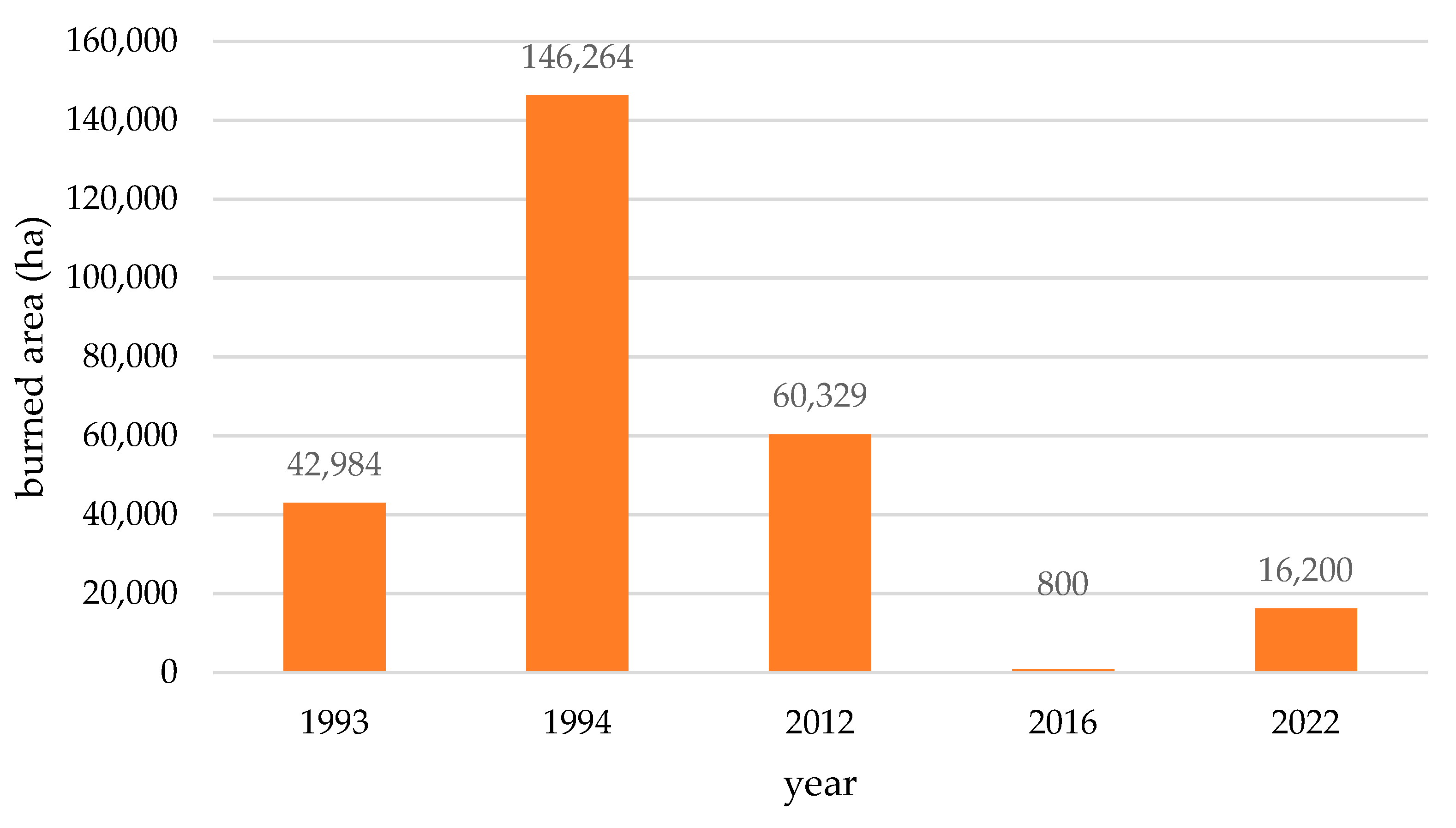Climate Resilience and Adaptive Strategies for Flood Mitigation: The Valencia Paradigm
Abstract
1. Introduction
1.1. Climate Events and Valencia’s Hydrographic Management
1.2. Policies Supporting River Restoration and Dam Removal: Agenda 2030 and SDG 6.2
1.3. Urban Expansion and Management
1.4. Forest Fire Impact
1.5. Implementing Nature-Based Solutions in Practice
2. Materials and Methods
2.1. Materials
2.1.1. The Severe Rainfall of 29 October 2024
2.1.2. Valencia’s Hydrographic Management
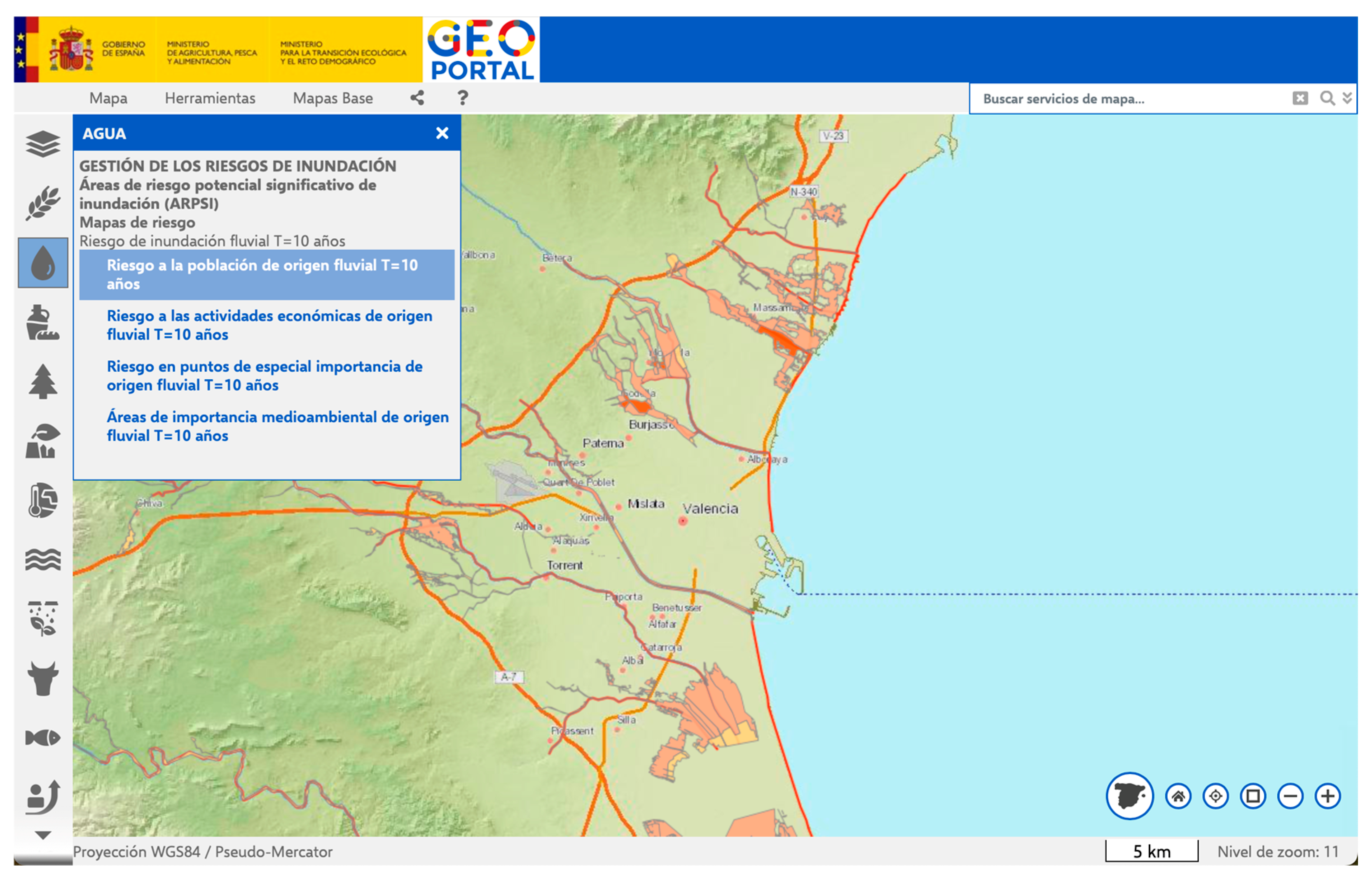
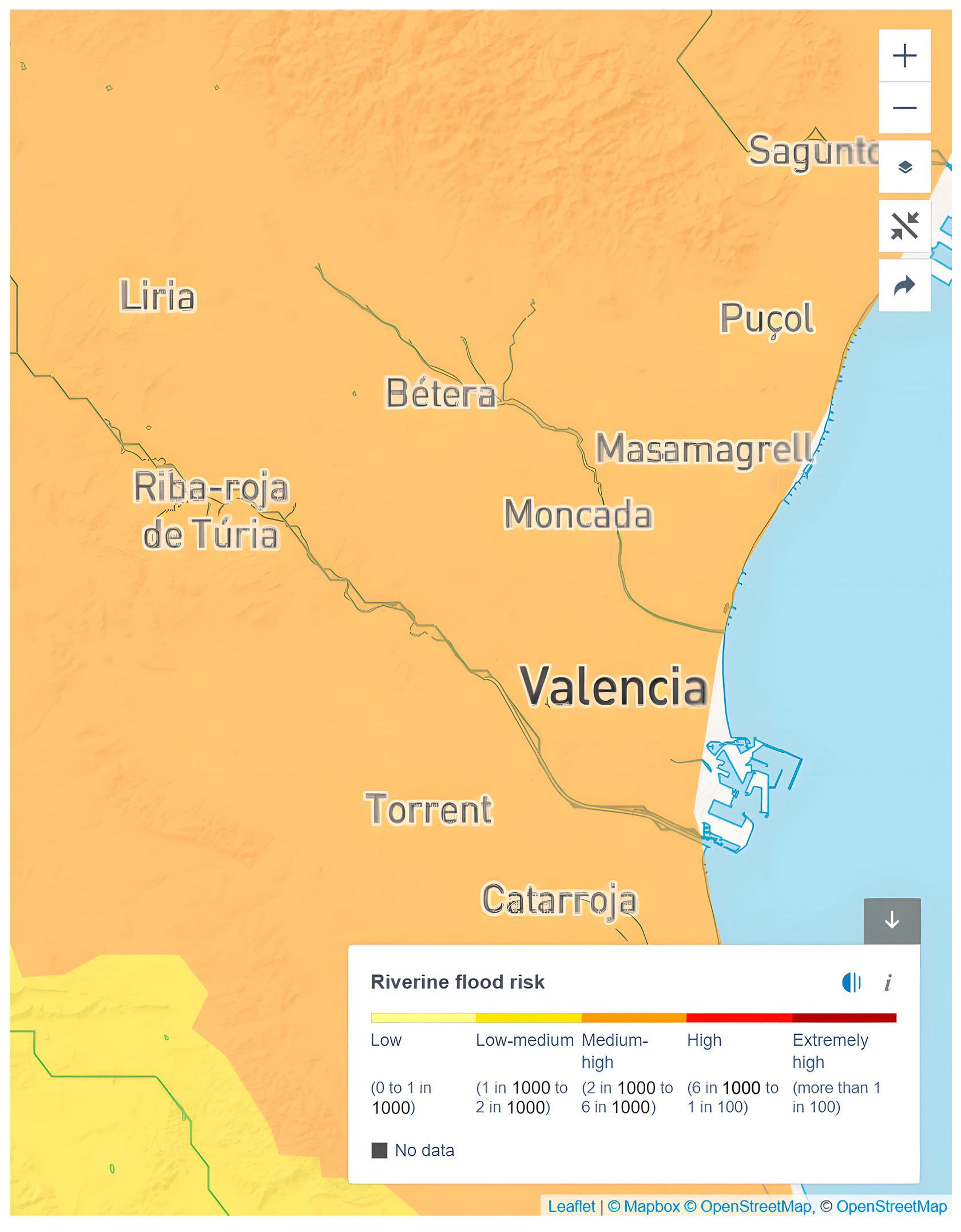
2.1.3. Valencia’s Urban Growth Management
2.1.4. Valencia’s Fire Forest Area
- Between 1993 and 2015, the Valencian Community experienced 8725 wildfires, which burned approximately 313,020 hectares of land. The year 2005 had the highest number of recorded wildfires (668); however, it was not the year with the most extensive area burned or the greatest number of casualties. The most challenging years for wildfire management were 1993, 1994, and 2012, with burned areas reaching 42,984 hectares, 146,264 hectares, and 60,329 hectares, respectively [37].
- In 2016, the Bolulla and Tàrbena municipalities in Alicante province were affected by wildfires that consumed around 800 hectares of forested area [34]
2.2. Methods
- The harmonization process established consistent temporal and spatial parameters across heterogeneous datasets to enable integrated analysis. We acquired and standardized data from multiple sources:
- Pluviometric intensity records from Agencia Estatal de Meteorología (AEMET);
- Dam decommissioning datasets from Ministerio para la Transición Ecológica y el Reto Demográfico (MITECO);
- Urban growth metrics from regional land-use studies;
- Pyrological datasets from Generalitat Valenciana and European Forest Fire Information System (EFFIS);
- 2.
- The validation process ensured data accuracy and reliability through the following systematic verification procedures:
- Comparative analysis of datasets to identify inconsistencies and anomalies;
- Iterative flagging and removal of errors and outliers;
- Cross-verification using official data sources from Spanish government and EU data bodies;
- 3.
- Triangulation approach based on data types enhanced its evaluation in three critical ways:
- Comparison of data types—started with a comparison between urban, agricultural, and ecological data, on their contribution to flood vulnerabilities in differently built environments;
- Interaction patterns—proceed with the identification of interaction patterns between external factors—such as how forest fire damage amplifies downstream flood vulnerability through altered soil permeability and increased sediment transport; and,
- Risk cross-validation—enclosed with the risks cross-validation to identify connections between anthropogenic activities and flood outcomes.
- 4.
- The synthesis phase compiled validated data, which integrates information from diverse scientific studies and official reports:
- Historical Event Analysis—Each flood event’s characteristics (rainfall, CO2 levels, severity, casualties) were derived from documented historical records from scientific studies [2,3,9,13] and validated newspaper archives such as Reuters [38,39], cross-validated with meteorological and hydrological datasets.
- Flood Severity Assessment—Flood impacts were evaluated on a standardized scale (1–5: Minor, Moderate, Serious, Severe, Catastrophic) based on documented impacts including displacement, property damage, and fatalities, informed by primary event descriptions and studies such as Schroeder et al. [41].
- 5.
- The final analytical phase examined the synthesized data through complementary approaches as follows:
- Hydrological Pattern Analysis—Examination of rainfall and flood event data to identify temporal shifts in hydrological patterns, with particular attention to changing precipitation intensity and frequency;
- Urban Impact Assessment—Evaluation of urbanization’s role in increasing flood vulnerability through analysis of land-use changes, impervious surface expansion, and altered drainage patterns;
- Environmental Vulnerability Analysis—Integration of forest fire data, sedimentation reports, and floodplain studies to assess how environmental degradation contributes to flood susceptibility;
- Spatial Vulnerability Mapping—Identification of geographic hotspots where multiple risk factors converge, creating areas of heightened vulnerability to flood events.
- Cascading Impact Modeling—Tracing how primary historical decisions trigger secondary morphological changes and tertiary impact consequences across interconnected systems, from immediate infrastructure damage to long-term ecological and socioeconomic effects.
3. Results
3.1. The Severe Flooding Events from 2023 to 2024 in the Mediterranean Region
3.2. The Severe Flooding Events from 1957 to 2024 in the Valencian Region
- Atmospheric CO2 concentrations have risen from approximately 315 ppm in 1957 to 420 ppm in 2024, reflecting the broader trend of anthropogenic climate change [2,40]. These rising CO2 levels align with increased global temperatures, contributing to a more moisture-laden atmosphere and potentially more intense rainfall events [72].
- Rainfall data demonstrates increasingly intense precipitation over time, with the 1982 Tous Dam flood recording over 500 mm in 24 h and the 2024 event recording 491 mm in just 8 h [72]. This trend suggests a shift toward shorter, more intense rainfall events linked to warmer atmospheric conditions.
- Flood severity is measured on a scale of 1 to 5, with the 1982 Tous Dam failure and the 2024 floods both rated as catastrophic (severity 5). Both events underscore the importance of infrastructure preparedness in mitigating flood impacts [13].
- Over the decades, flood events in Valencia have resulted in significant casualties, including 81 fatalities during the 1957 flood, 8 fatalities and 100,000 evacuations from the 1982 Tous Dam collapse, and 217 fatalities in the 2024 Valencia flood, highlighting the escalating human impact of such disasters over time.
3.3. Urban Expansion and the Flood Risks in the Valencian Region
4. Discussion
- Ebro Delta Restoration Project (Spain): Faced with rising sea levels and sediment loss, the Ebro Delta project utilized NBS-like wetland restoration and sediment management to combat coastal erosion and flooding. Community involvement played a critical role in monitoring and maintaining restored areas, while EU funding ensured the sustainability of the initiative [86].
- Floodplain Restoration in the Po River Basin (Italy): To address recurrent flooding, this project restored natural floodplains and reconnected rivers to their surrounding ecosystems. Local farmers and landowners were actively engaged through compensation schemes and collaborative planning processes, ensuring the project’s acceptance [87].
- Ecosystem-Based Adaptation in the Nile Basin (Egypt): In response to water scarcity and climate variability, Egypt implemented ecosystem-based approaches, such as wetland conservation and afforestation, to stabilize water systems. International funding from climate adaptation programs supported these efforts, demonstrating the scalability of NBS [88].
- Blue–Green Infrastructure in Thessaloniki (Greece): Thessaloniki integrated green corridors and permeable surfaces into its urban fabric to improve stormwater management and mitigate urban heat islands. Local stakeholder workshops ensured the adaptation of designs to community needs, while European cohesion funds provided financial backing [35].
- Use controlled burns and sustainable grazing to limit flammable biomass.
- Implement reforestation and soil stabilization to reduce sedimentation and restore hydrological balance [22].
- Promote policies that encourage active land management and reduce fuel accumulation [19].
- Utilize satellite imaging and hydrological models to predict fire-related flood risks and improve response strategies [6].
- Policies should consider regional environmental, cultural, and economic factors, rather than applying global standards uniformly [13].
- Rather than demanding immediate transformation, gradual adaptation allows communities time to adjust, especially in high-risk areas.
- Community organizations and local governments must be empowered with financial and technical support to ensure effective, inclusive decision-making.
- Hydrological assessments and adaptive management strategies should inform policy decisions, recognizing that sustainability is an evolving process rather than a fixed goal [6].
5. Conclusions
- Complex Interplay of Climate and Human Activities: While climate change is an undeniable driver of increased flood risks, attributing all hydrological challenges solely to it oversimplifies the issue. Human activities, including urban expansion, river sediment exploitation, and inadequate maintenance of infrastructure, have played a significant role in intensifying these risks. Addressing these challenges requires a balance between mitigating climate change impacts and rectifying historical human interventions.
- Urbanization and Soil Sealing: The rapid urbanization of Valencia has significantly increased impermeable surfaces, increasing surface runoff and reducing the natural capacity for water absorption. Policies promoting green infrastructure, such as permeable pavements and urban green spaces, are essential to counteract these impacts. However, their implementation must consider the socio-economic and cultural dynamics of local communities.
- NBS and Their Limitations: NBS, such as floodplain restoration and dam removal, offer benefits in enhancing biodiversity and ecological resilience. However, these strategies are not without challenges, including increased river flow speeds and downstream sedimentation. Hybrid approaches that integrate ecological and engineered solutions are critical to achieving sustainable outcomes.
- The Role of Forest Fires: Forest fires have significantly altered the hydrology and sediment dynamics of the region, contributing to increased runoff and erosion. These impacts are compounded by land abandonment and inadequate fire management practices. Effective solutions must include proactive vegetation management, erosion control, and hydrological monitoring.
- Global Frameworks vs. Local Realities: The implementation of global policies, such as the UN-SDGs, often prioritizes rapid and transformative changes. However, these frameworks can overlook the specific socio-economic and ecological realities of regions like Valencia. A gradual, community-driven approach is essential to ensure the sustainability and acceptance of these policies.
- Community Engagement as a Cornerstone: Meaningful progress in hydrological and environmental management requires the active participation of local stakeholders. Integrating traditional knowledge and empowering local communities can bridge the gap between global aspirations and practical implementation.
Author Contributions
Funding
Institutional Review Board Statement
Informed Consent Statement
Data Availability Statement
Acknowledgments
Conflicts of Interest
Abbreviations
| AEMET | Agencia Estatal de Meteorología (State Meteorological Agency, Spain) |
| CEMS | Copernicus Emergency Management Service |
| CJP | Climate Judiciary Project |
| CHJ | Confederación Hidrográfica del Júcar (Júcar River Basin Confederation) |
| DANA | Depresión Aislada en Niveles Altos (Isolated Depression at High Levels) |
| EFFIS | European Forest Fire Information System |
| ESA | European Space Agency |
| GIF | Grans Incendis Forestals (Large Forest Fires) |
| MITECO | Ministerio para la Transición Ecológica y el Reto Demográfico (Ministry for Ecological Transition and Demographic Challenge, Spain) |
| NBS | Nature-Based Solutions |
| SDG | Sustainable Development Goals |
| UN | United Nations |
| WUI | Wildland-Urban Interface |
References
- ESA Valencia Flood Disaster. Available online: https://www.esa.int/ESA_Multimedia/Images/2024/10/Valencia_flood_disaster (accessed on 29 January 2025).
- Gómez-Martínez, G.; Galiano, L.; Rubio, T.; Prado-López, C.; Redolat, D.; Paradinas Blázquez, C.; Gaitán, E.; Pedro-Monzonís, M.; Ferriz-Sánchez, S.; Añó Soto, M.; et al. Effects of Climate Change on Water Quality in the Jucar River Basin (Spain). Water 2021, 13, 2424. [Google Scholar] [CrossRef]
- Camarasa Belmonte, A.M.; Segura Beltrán, F. Flood events in Mediterranean ephemeral streams (ramblas) in Valencia region, Spain. CATENA 2001, 45, 229–249. [Google Scholar] [CrossRef]
- Llasat, M.-C.; Barriendos, M.; Barrera, A.; Rigo, T. Floods in Catalonia (NE Spain) since the 14th century. Climatological and meteorological aspects from historical documentary sources and old instrumental records. J. Hydrol. 2005, 313, 32–47. [Google Scholar] [CrossRef]
- Vallve, M.B.; Martin-Vide, J. Secular Climatic Oscillations as Indicated by Catastrophic Floods in the Spanish Mediterranean Coastal Area (14th–19th Centuries). Clim. Change 1998, 38, 473–491. [Google Scholar] [CrossRef]
- Mason, D.C.; Davenport, I.J.; Neal, J.C.; Schumann, G.J.-P.; Bates, P.D. Near Real-Time Flood Detection in Urban and Rural Areas Using High-Resolution Synthetic Aperture Radar Images. IEEE Trans. Geosci. Remote Sens. 2012, 50, 3041–3052. [Google Scholar] [CrossRef]
- Tanim, A.H.; McRae, C.B.; Tavakol-Davani, H.; Goharian, E. Flood Detection in Urban Areas Using Satellite Imagery and Machine Learning. Water 2022, 14, 1140. [Google Scholar] [CrossRef]
- EC River Basin Management in a Changing Climate. Available online: https://environment.ec.europa.eu/publications/river-basin-management-changing-climate_en (accessed on 29 January 2025).
- Faus Prieto, A. La riada del Turia de 1731. Una aproximación a la literatura de la catástrofe. Investig. Geográficas 2015, 64, 129–143. [Google Scholar] [CrossRef]
- Camprubí, L. Engineers and the Making of the Francoist Regime; The MIT Press: Cambridge, MA, USA, 2014; ISBN 978-0-262-32322-2. [Google Scholar]
- Rubio-Martin, A.; Pulido-Velazquez, M.; Macian-Sorribes, H.; Garcia-Prats, A. System Dynamics Modeling for Supporting Drought-Oriented Management of the Jucar River System, Spain. Water 2020, 12, 1407. [Google Scholar] [CrossRef]
- González del Tánago, M.; García de Jalón, D.; Román, M. River Restoration in Spain: Theoretical and Practical Approach in the Context of the European Water Framework Directive. Environ. Manag. 2012, 50, 123–139. [Google Scholar] [CrossRef]
- Schoolmeesters, R. Tous Dam (Spain, 1982)|Case Study|ASDSO Lessons Learned. Available online: https://damfailures.org/case-study/tous-dam-spain-1982/ (accessed on 29 January 2025).
- Batalla, R.J. Sediment deficit in rivers caused by dams and instream gravel mining. A review with examples from NE Spain. Cuaternario Geomorfol. Rev. Soc. Esp. Geomorfol. Asoc. Esp. Para El Estud. Cuaternario 2003, 17, 79–91, ISSN 0214-1744. [Google Scholar]
- UN Transforming Our World: The 2030 Agenda for Sustainable Development|Department of Economic and Social Affairs. Available online: https://sdgs.un.org/publications/transforming-our-world-2030-agenda-sustainable-development-17981 (accessed on 29 January 2025).
- MITECO. Strategic Orientations on Water and Climate Change; MITECO: Madrid, Spain, 2022. [Google Scholar]
- Valera, A.; Vidal, C.; Sánchez, J. Urban growth (1956-2012) and soil sealing in the metropolitan area of Valencia (Eastern Spain). Span. J. Soil Sci. 2019, 9, 88–104. [Google Scholar] [CrossRef]
- Miralles i García, J. The Introduction of the Sustainability in the Procedures Regulated for Urban Planning: The Case of the Last Act on Urbanism, Territory and Landscape in the Valencian Community (Spain); WIT Press: Billerica, MA, USA, 2007; p. 513. ISBN 978-1-84564-069-9. [Google Scholar]
- López-Poma, R.; Orr, B.J.; Bautista, S. Successional stage after land abandonment modulates fire severity and post-fire recovery in a Mediterranean mountain landscape. Int. J. Wildland Fire 2014, 23, 1005–1015. [Google Scholar] [CrossRef]
- Barberà, M.J.; Niclòs, R.; Estrela, M.J.; Valiente, J.A. Climatology of the stability and humidity terms in the Haines Index to improve the estimate of forest fire risk in the Western Mediterranean Basin (Valencia region, Spain). Int. J. Climatol. 2015, 35, 1212–1223. [Google Scholar] [CrossRef]
- Cerda, A.; Imeson, A.C.; Calvo, A. Fire and aspect induced differences on the erodibility and hydrology of soils at La Costera, Valencia, southeast Spain. CATENA 1995, 24, 289–304. [Google Scholar] [CrossRef]
- Fernández-Manso, A.; Quintano, C.; Fernández-Guisuraga, J.M.; Roberts, D. Next-gen regional fire risk mapping: Integrating hyperspectral imagery and National Forest Inventory data to identify hot-spot wildland-urban interfaces. Sci. Total Environ. 2024, 940, 173568. [Google Scholar] [CrossRef]
- EPC The Assessment of the Effects of Certain Public and Private Projects on the Environment. Available online: https://eur-lex.europa.eu/eli/dir/2014/52/oj/eng (accessed on 27 January 2025).
- AEMET. Informe Sobre el Episodio Meteorológico de Precipitaciones Torrenciales y Persistentes Ocasionadas por una DANA el día 29 de Octubre de 2024; AEMET: Madrid, Spain, 2024. [Google Scholar]
- Pucik, T. Meteorological Analysis of Extreme Flash Flood Situation in the Valencia Region; European Severe Storms Laboratory: Weßling, Germany, 2024. [Google Scholar]
- NASA. Valencia Floods. Available online: https://earthobservatory.nasa.gov/images/153533/valencia-floods (accessed on 29 January 2025).
- ESA Devastating Floods in Spain Witnessed by Satellites. Available online: https://www.esa.int/Applications/Observing_the_Earth/Devastating_floods_in_Spain_witnessed_by_satellites (accessed on 29 January 2025).
- MITECO. Seguimiento e Implantación de la Estrategia Nacional de Restauración de Ríos. Available online: https://www.miteco.gob.es/es/agua/temas/delimitacion-y-restauracion-del-dominio-publico-hidraulico/estrategia-nacional-restauracion-rios/seguimiento-e-implantacion.html (accessed on 29 January 2025).
- World Resources Institute Aqueduct Water Risk Atlas. Available online: https://www.wri.org/applications/aqueduct/water-risk-atlas/#/?advanced=false&basemap=hydro&indicator=rfr_cat&lat=39.45899296747316&lng=-0.37010192871093756&mapMode=view&month=1&opacity=0.5&ponderation=DEF&predefined=false&projection=absolute&scenario=optimistic&scope=baseline&timeScale=annual&year=baseline&zoom=12 (accessed on 29 January 2025).
- Maldita Disinformation Narratives Blaming Imaginary “Dam and Reservoir Demolitions” of the Consequences of the Floods in Valencia·Maldita.es-Periodismo Para que no te la Cuelen. Available online: https://maldita.es/clima/20241104/dams-reservoirs-removed-floods-valencia/ (accessed on 29 January 2025).
- MITECO. Geoportal. Available online: https://sig.mapama.gob.es/geoportal/ (accessed on 29 January 2025).
- World Population Review Valencia, Spain Population 2024. Available online: https://worldpopulationreview.com/cities/spain/valencia?utm_source (accessed on 30 January 2025).
- Simon, E.; Bin, I.H.; Sipos, B.; Abriha-Molnár, V.É.; Abriha, D.; Andreu-Sanchez, O.; Boluda, R.; Roca-Pérez, L. Effect of urbanisation on soil and plant pollution in province of Valencia, Spain). bioRxiv 2024, 2024.03.27.586674. [Google Scholar] [CrossRef]
- Generalitat Valenciana Estadística d’incendis Forestals-Prevención de Incendios Forestales y Sensibilización. Available online: https://mediambient.gva.es/va/web/prevencion-de-incendios/estadistica-de-incendios-forestales (accessed on 29 January 2025).
- Kirkland, M.; Atkinson, P.W.; Aliácar, S.; Saavedra, D.; De Jong, M.C.; Dowling, T.P.F.; Ashton-Butt, A. Protected areas, drought, and grazing regimes influence fire occurrence in a fire-prone Mediterranean region. Fire Ecol. 2024, 20, 88. [Google Scholar] [CrossRef]
- Copernicus European Forest Fire Information System. Available online: https://forest-fire.emergency.copernicus.eu/ (accessed on 29 January 2025).
- Zambon, I.; Cerdà, A.; Cudlin, P.; Serra, P.; Pili, S.; Salvati, L. Road Network and the Spatial Distribution of Wildfires in the Valencian Community (1993–2015). Agriculture 2019, 9, 100. [Google Scholar] [CrossRef]
- Aguado, J. Economic Impact of Floods in Spain Could Rise to over 10 Bln Euros; Reuters: London, UK, 2024. [Google Scholar]
- Khalip, A.; Landauro, I. What Caused Deadly Floods in Spain? The Impact of DANA Explained; Reuters: London, UK, 2024. [Google Scholar]
- Estrela, T.; Pérez-Martin, M.A.; Vargas, E. Impacts of climate change on water resources in Spain. Hydrol. Sci. J. 2012, 57, 1154–1167. [Google Scholar] [CrossRef]
- Schroeder, A.J.; Gourley, J.J.; Hardy, J.; Henderson, J.J.; Parhi, P.; Rahmani, V.; Reed, K.A.; Schumacher, R.S.; Smith, B.K.; Taraldsen, M.J. The development of a flash flood severity index. J. Hydrol. 2016, 541, 523–532. [Google Scholar] [CrossRef]
- CJP. Drawing the Causal Chain: The Detection and Attribution of Climate Change. Available online: https://cjp.eli.org/curriculum/drawing-causal-chain-detection-and-attribution-climate-change (accessed on 29 January 2025).
- Kahlenborn, W.; Voss, M.; Porst, L.; Zebisch, M.; Renner, K.; Schauser, I. Integrated risk analyses as part of national climate risk assessments: Lessons learnt from the climate risk assessment of Germany. Int. J. Clim. Change Strateg. Manag. 2025; ahead-of-print. [Google Scholar] [CrossRef]
- Climate Change Committee. UK Climate Change Risk Assessment 2017 Evidence Report; Climate Change Comittee: London, UK, 2017; p. 23. Available online: https://www.theccc.org.uk/wp-content/uploads/2016/07/UK-CCRA-2017-Launch-slidepack.pdf (accessed on 29 January 2025).
- Actualización de datos del Gobierno de España. Available online: https://www.lamoncloa.gob.es/info-dana/paginas/2024/191124-datos-seguimiento-actuaciones-gobierno.aspx (accessed on 4 March 2025).
- El País ‘Tragedy of Absolutely Incredible Dimensions’: Death Toll Continues to Rise After Flash Flooding in Spain. Available online: https://english.elpais.com/spain/2024-10-30/at-least-51-killed-in-flooding-in-spain.html (accessed on 29 January 2025).
- EWN Algarve Hit by Flash Floods due to DANA. Available online: https://euroweeklynews.com/2024/11/15/algarve-portugal-hit-by-flash-floods-due-to-dana-5-minute-rainfall/ (accessed on 29 January 2025).
- Associated Press New Storms and Flooding Threaten Spain’s Hard-Hit Valencia Again. Available online: https://apnews.com/article/spain-floods-malaga-79ec155360f14a0b89a788e8cb6787b4 (accessed on 29 January 2025).
- WMO. Devastating Rainfall Hits Spain in Yet Another Flood-Related Disaster. Available online: https://wmo.int/media/news/devastating-rainfall-hits-spain-yet-another-flood-related-disaster (accessed on 29 January 2025).
- Tanno, S.; Paddison, L.; Brown, B.; Mosquera, P. 20241030-Spain-Rainfall. Available online: https://ix.cnn.io/dailygraphics/graphics/20241030-spain-rainfall/index.html?initialWidth=910&childId=graphic-20241030-spain-rainfall&parentTitle=Spain%20hit%20by%20deadliest%20floods%20in%20decades.%20Here%E2%80%99s%20what%20we%20know%20%7C%20CNN&parentUrl=https%3A%2F%2Fedition.cnn.com%2F2024%2F10%2F31%2Feurope%2Fspain-deadly-flash-flooding-wwk-intl%2Findex.html (accessed on 29 January 2025).
- Borrego, J.B. Outdated regulations and institutional vulnerability: Hydrological risk management in Málaga’s municipal planning. Heliyon 2023, 9, e18691. [Google Scholar] [CrossRef]
- Sioutas, M.; Lekidis, V.; Kokolakis, C. Flooding Phenomena in the Metropolitan Area of Thessaloniki: Anthropogenic and Climate Change Effects. In Proceedings of the SafeAttica 2023; SafeGreece: Athens, Greece, 26 December 2023. 2023, pp. 133–136, EgyptToday Alexandria has Witnessed Heavy Torrential Rains, Floods Since 2015: Governor. Available online: https://www.egypttoday.com/Article/1/109552/Alexandria-has-witnessed-heavy-torrential-rains-floods-since-2015-Governor (accessed on 29 January 2025).
- País, E. Storms in Spain Head for Western Andalusia after Lashing Málaga and Valencia. Available online: https://english.elpais.com/climate/2024-11-14/storms-in-spain-head-for-western-andalusia-after-lashing-malaga-and-valencia.html (accessed on 30 January 2025).
- Cima Research Foundation Greece Floods: Data, Forecasts, and Scientific Analysis of the Event. BBC News Libya Floods: Why Damage to Derna was so Catastrophic. 2023. Available online: https://www.cimafoundation.org/en/news/greece-floods-data-forecasts-and-scientific-analysis-of-the-event/ (accessed on 30 January 2025).
- Orellana, J.S. El Ayuntamiento de Málaga Cancela o Pospone los actos Organizados por los Distritos con Motivo de Halloween. Available online: https://cadenaser.com/andalucia/2024/10/31/el-ayuntamiento-de-malaga-cancela-o-pospone-los-actos-organizados-por-los-distritos-con-motivo-de-halloween-ser-malaga/ (accessed on 30 January 2025).
- MedCyclones. Mediterranean Cyclone Daniel, 3–11 September 2023; MedCyclones, 2023; p. 3, Contreras, V. Una Inundación Como Cuatro Veces la Ciudad de València; Available online: https://www.levante-emv.com/comunitat-valenciana/2024/11/12/dana-valencia-la-zona-inundada-supera-cuatro-veces-el-termino-de-valencia-cartografia-111605143.html (accessed on 30 January 2025).
- He, K.; Yang, Q.; Shen, X.; Dimitriou, E.; Mentzafou, A.; Papadaki, C.; Stoumboudi, M.; Anagnostou, E. Brief communication: Storm Daniel flood impact in Greece in 2023: Mapping crop and livestock exposure from synthetic-aperture radar (SAR). Nat. Hazards Earth Syst. Sci. 2024, 24, 2375–2382. [Google Scholar] [CrossRef]
- Le Monde with AFP Libya Floods: Inhabitants of Derna Ask for Accountability. Le Monde 2023. Paris, France. La Vanguardia Normalcy Will Take Time to Reach Spain’s Flooded Areas. Available online: https://www.lavanguardia.com/mediterranean/20241105/10080597/normality-time-cold-drop-valencia-massanassa-catarroja-army-epicenter-rainfall-mud-street-flood.html (accessed on 30 January 2025).
- Bostyn, Y. These Are the Malaga Towns Most at Risk From Flooding During Red-Level Rain Storms; Olive Press News Spain: Málaga, Spain, 2024. [Google Scholar]
- Libya-Impact of Storm Daniel: An Update on Displacement and Needs (November 2023)-Libya|ReliefWeb. Available online: https://reliefweb.int/report/libya/libya-impact-storm-daniel-update-displacement-and-needs-november-2023 (accessed on 30 January 2025).
- Euronews. At least Four People Die after Severe Floods Hit Greece. Available online: https://www.euronews.com/2023/09/07/at-least-four-people-die-after-severe-floods-hit-greece (accessed on 30 January 2025).
- The Globe and Mail Death Toll Soars to 11,300 in Flooding in Libya’s Coastal City of Derna, Libyan Red Crescent Says. Available online: https://www.theglobeandmail.com/world/article-libya-flood-casualties-could-have-been-avoided-with-warning-system/ (accessed on 30 January 2025).
- Cabezas, E. Malaga Villages Slowly Return to Normal One Month on from the Floods. Available online: https://www.surinenglish.com/malaga/axarquia/benamargosa-and-comares-recover-one-month-after-20241216080215-nt.html (accessed on 30 January 2025).
- Orellana, J.S. Álora (Málaga), Tres Meses Después de la Catástrofe que Provocó la DANA: “El Gobierno Central no nos ha Dado ni un Céntimo”. Available online: https://cadenaser.com/andalucia/2025/01/29/alora-malaga-tres-meses-despues-de-la-catastrofe-que-provoco-la-dana-el-gobierno-central-no-nos-ha-dado-ni-un-centimo-ser-malaga/ (accessed on 30 January 2025).
- Death Toll Rises in Greece as Flooding Devastates Thessaly Region. Available online: https://www.wsws.org/en/articles/2023/09/14/asmd-s14.html (accessed on 30 January 2025).
- ReliefWeb Libya Hurricane Daniel: Situation Report 2-27/09/2023-Libya. Available online: https://reliefweb.int/report/libya/libya-hurricane-daniel-situation-report-2-27092023 (accessed on 30 January 2025).
- AP News Spain’s Catastrophic Floods by the Numbers: At Least 219 Dead, 93 Missing and Billions in Damage. Available online: https://apnews.com/article/spain-floods-valencia-numbers-21fccd4a9eba4fada0745db0a5a0dd12 (accessed on 30 January 2025).
- NASA Science Evidence 2022. Available online: https://science.nasa.gov/climate-change/evidence/ (accessed on 29 January 2025).
- Visor Cartogràfic de la Generalitat. Available online: https://visor.gva.es/visor/?extension=266363,4115432,1161436,4619187&nivelZoom=8&capasids=Orto_Actual;,Ordenacion_Territorial;12,Ordenacion_Territorial;11,Ordenacion_Territorial;10,Ordenacion_Territorial;9,Ordenacion_Territorial;8,Ordenacion_Territorial;7,Ordenacion_Territorial;6,Ordenacion_Territorial;5,Ordenacion_Territorial;4,Ordenacion_Territorial;3,Ordenacion_Territorial;1&tcapas=1.0,1.0,1.0,1.0,1.0,1.0,1.0,1.0,1.0,1.0,1.0,1.0&idioma=es (accessed on 31 March 2025).
- Lehoczky, A.; Sobrino, J.A.; Skoković, D.; Aguilar, E. The Urban Heat Island Effect in the City of Valencia: A Case Study for Hot Summer Days. Urban Sci. 2017, 1, 9. [Google Scholar] [CrossRef]
- Portugués, I.; Bonache, X.; Mateu, J.F.; Marco, J.; Bonache i Felici, X. A GIS-Based Model for the analysis of an urban flash flood and its hydro-geomorphic response. The Valencia event of 1957. J. Hydrol. 2016, 541, 582–596. [Google Scholar] [CrossRef]
- Karagianni, M. Making Thessaloniki Resilient? The Enclosing Process of the Urban Green Commons. Urban Plan. 2023, 8, 346–360. [Google Scholar] [CrossRef]
- Sinthumule, N.I.; Mudau, N.V. Participatory approach to flood disaster management in Thohoyandou. Jàmbá J. Disaster Risk Stud. 2019, 11, 1–7. [Google Scholar] [CrossRef]
- Meyer, M.; Hendricks, M.D.; Newman, G.D.; Horney, J.; Berke, P.; Masterson, J.; Sansom, G.; Cousins, T.; Zandt, S.V.; Cooper, J. Participatory Action Research: Tools for Disaster Resilience Education. Int. J. Disaster Resil. Built Environ. 2018, 9, 402–419. [Google Scholar] [CrossRef]
- Khaspuria, G.; Ranjan, A.; Sahil; Soni, P.; Dadhich, K. Natural Disaster Mitigation Strategies: A Comprehensive Review. J. Sci. Res. Rep. 2024. [Google Scholar] [CrossRef]
- Duffaut, C.; Frascaria-Lacoste, N.; Versini, P. Barriers and Levers for the Implantation of Sustainable Nature-Based Solutions in Cities: Insights from France. Sustainability 2022, 14, 9975. [Google Scholar] [CrossRef]
- Lupp, G.; Huang, J.; Zingraff-Hamed, A.; Oen, A.M.P.; Sepia, N.D.; Martinelli, A.; Lucchesi, M.; Knutsen, T.W.; Olsen, M.; Fjøsne, T.; et al. Stakeholder Perceptions of Nature-Based Solutions and Their Collaborative Co-Design and Implementation Processes in Rural Mountain Areas—A Case Study From PHUSICOS. Front. Environ. Sci. 2021, 9, 12. [Google Scholar] [CrossRef]
- Solheim, A.; Capobianco, V.; Oen, A.M.P.; Kalsnes, B.; Wullf-Knutsen, T.; Olsén, M.; Seppia, N.D.; Arauzo, I.; Balaguer, E.G.; Strout, J. Implementing Nature-Based Solutions in Rural Landscapes: Barriers Experienced in the PHUSICOS Project. Sustainability 2021, 13, 1461. [Google Scholar] [CrossRef]
- EPC Framework for Community Action in the Field of Water Policy. Available online: https://eur-lex.europa.eu/eli/dir/2000/60/2014-11-20/eng (accessed on 27 January 2025).
- Maes, J.; Jacobs, S. Nature-Based Solutions for Europe’s Sustainable Development. Conserv. Lett. 2017, 10, 121–124. [Google Scholar] [CrossRef]
- Biasin, A.; Masiero, M.; Amato, G.; Pettenella, D. Nature-Based Solutions Modeling and Cost-Benefit Analysis to Face Climate Change Risks in an Urban Area: The Case of Turin (Italy). Land 2023, 12, 280. [Google Scholar] [CrossRef]
- Toxopeus, H.S.; Polzin, F. Reviewing financing barriers and strategies for urban nature-based solutions. J. Environ. Manag. 2021, 289, 112371. [Google Scholar] [CrossRef]
- Andrikopoulou, T.; Schielen, R.; Spray, C.; Schipper, C.; Blom, A. A Framework to Evaluate the SDG Contribution of Fluvial Nature-Based Solutions. Sustainability 2021, 13, 11320. [Google Scholar] [CrossRef]
- Sopena Porta, M.P.; Pellicer, F. Urban Planning and Landscape Projects on Urban Riverbanks in Europe: Comparative Study of the Ebro River, Zaragoza, and the Isar River, Munich. Urban Sci. 2024, 8, 152. [Google Scholar] [CrossRef]
- Frascaroli, F.; Parrinello, G.; Root-Bernstein, M. Linking contemporary river restoration to economics, technology, politics, and society: Perspectives from a historical case study of the Po River Basin, Italy. Ambio 2021, 50, 492–504. [Google Scholar] [CrossRef]
- Al-Saidi, M.; Elagib, N.A.; Ribbe, L.; Schellenberg, T.; Roach, E.; Oezhan, D. Water-Energy-Food Security Nexus in the Eastern Nile Basin. In Water-Energy-Food Nexus; American Geophysical Union (AGU): Washington, DC, USA, 2017; pp. 103–116. ISBN 978-1-119-24317-5. [Google Scholar]
- Kastanidou, S.; Katsavounidou, G. Urban streams as focal points of urban regeneration: The area of Konstantinidis stream in Toumba, Thessaloniki. E3S Web Conf. 2024, 585, 09001. [Google Scholar] [CrossRef]
- Jing, L.; Zeng, Q.; He, K.; Liu, P.; Fan, R.; Lu, W.; Lei, G.; Lu, C.; Wen, L. Vegetation Dynamic in a Large Floodplain Wetland: The Effects of Hydroclimatic Regime. Remote Sens. 2023, 15, 2614. [Google Scholar] [CrossRef]
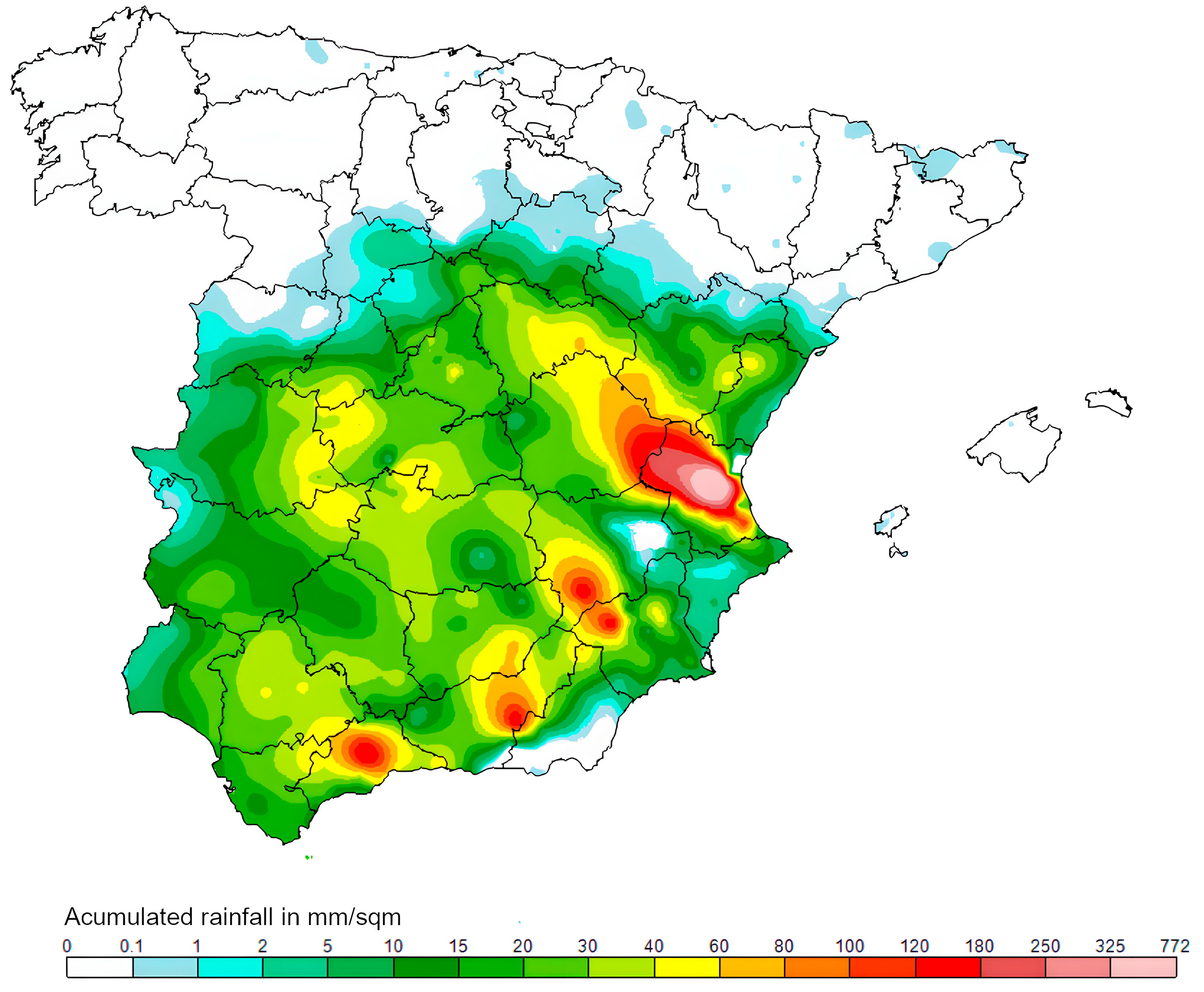

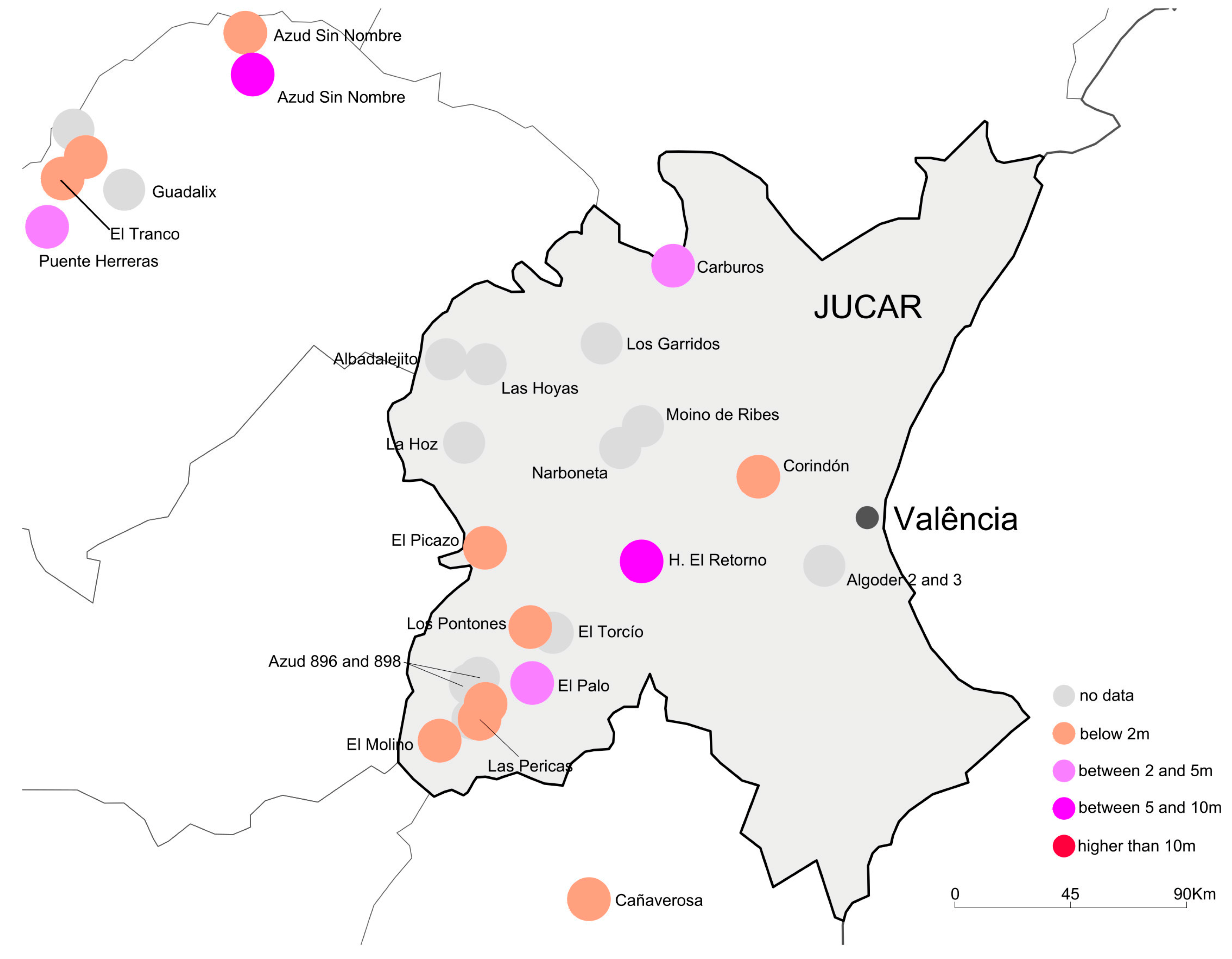
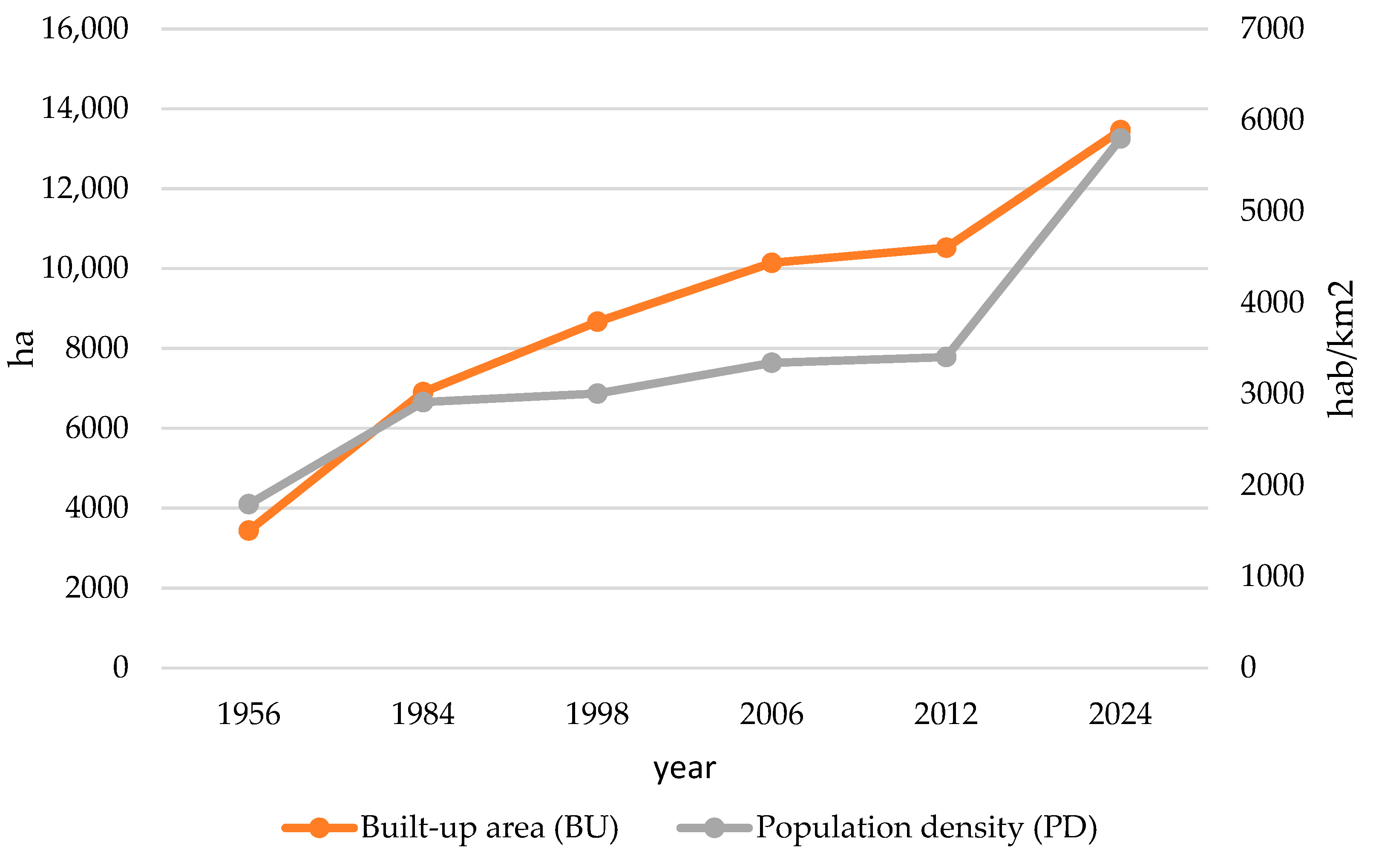
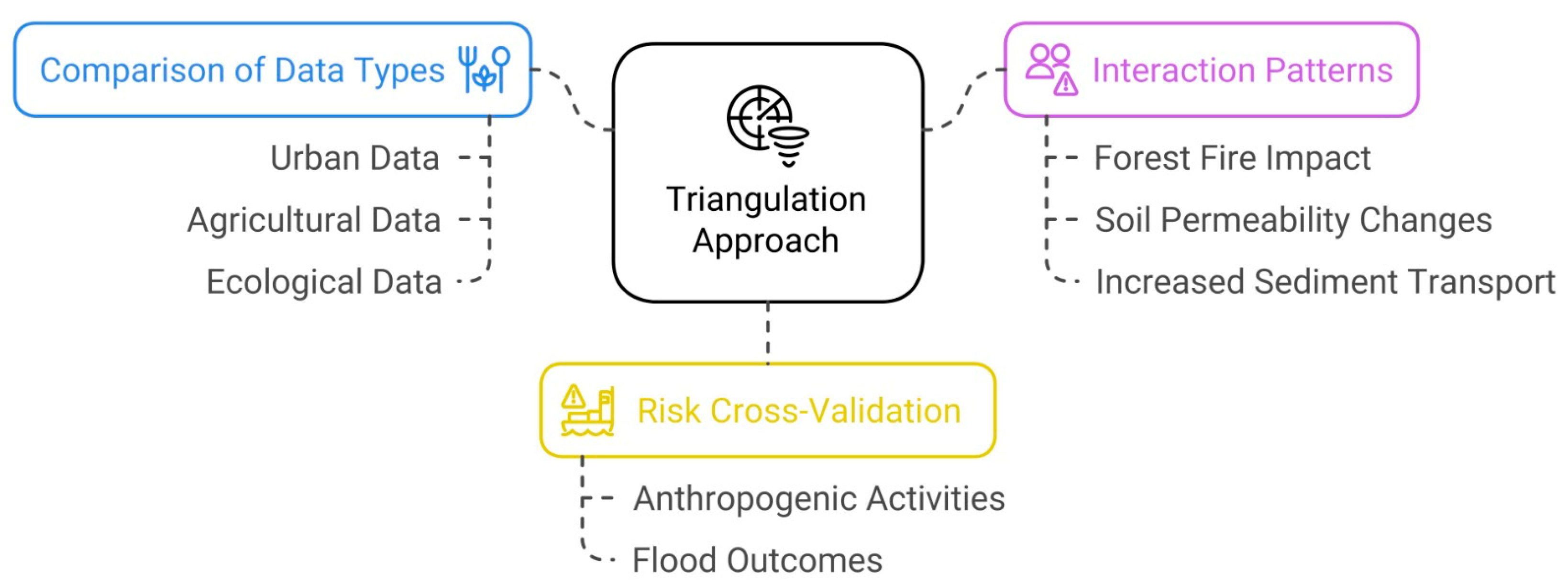
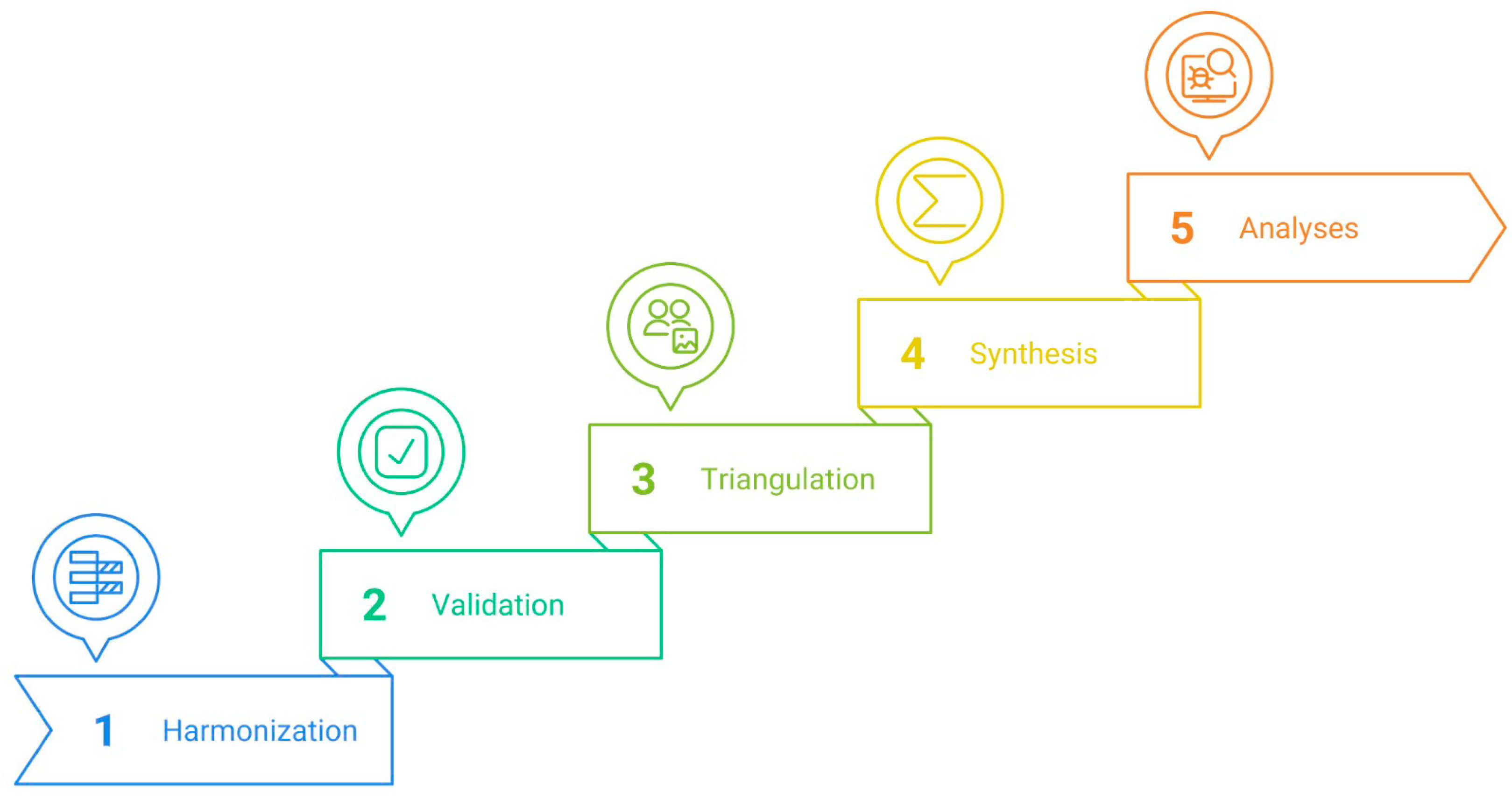
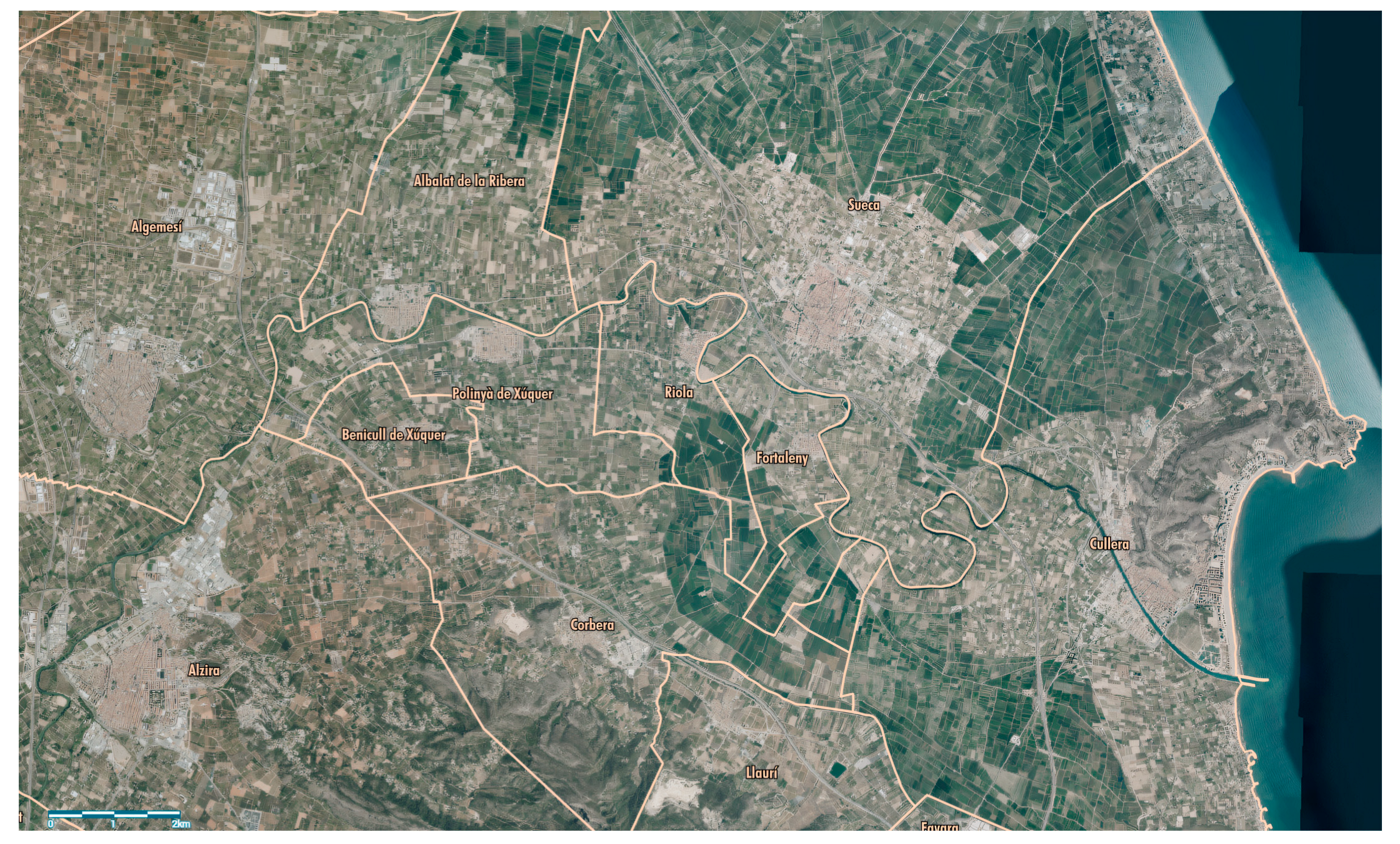
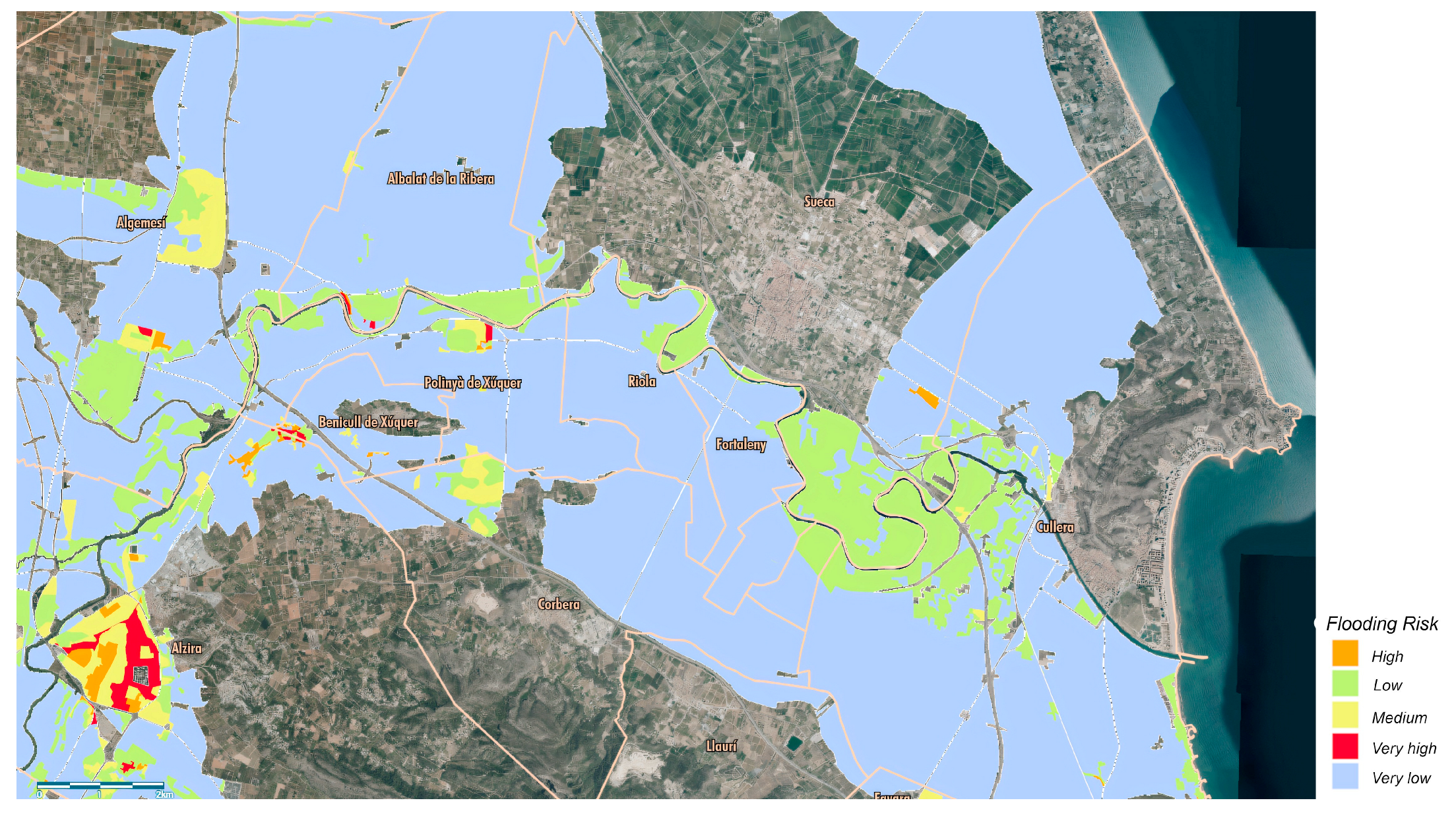
| Valencia, Spain (2024) | Málaga, Spain (2024) | Athens, Greece (2023) | Derna, Lybia (2023) | |
|---|---|---|---|---|
| Precipitation (mm) | 491 mm in 8 h [52] | 114 mm in 24 h [54] | 700–800 mm in 24 h [55] | 400 mm in 24 h [56] |
| Duration (Hours/Days) | 2 Days [52] | 2 Day [57] | 8 Days [58] | 3 Days [56] |
| Affected Area (km2) | 562.7 km2 [59] | - | 1150 km2 [60] | 6 km2 (highly dense urban area) [61] |
| Population Affected | +800,000 [62] | 206,971 [63] | 225,000 [55] | 44,862 [64] |
| Casualties | 229 [39] | 1 [63] | 4 [65] | 11.300 [66] |
| Infrastructure Damaged | residential areas, industrial, commercial, public services, and public infrastructures [37,43,46,49,52] | residential areas, agricultural areas, public infrastructures [54,57,63,67,68] | residential areas, agricultural areas, public infrastructures [55,58,60,65,69] | residential areas, public infrastructures (two dams damaged) [56,61,64,66,70] |
| Economic Impact (€) | + €10 billion [71] | €3.5 billion [67,68] | €2.25 billion [69] | €18.3 billion (from 19 billion USD) [70] |
| Metric | 1957 Event | 1982 Event (Tous Dam) | 2000 Event | 2007 Event | 2024 Event |
|---|---|---|---|---|---|
| CO2 Levels (ppm) | ~315 | ~340 | ~370 | ~380 | ~420 |
| Maximum Rainfall (mm) | ~200–300 in 24 h | >500 in 24 h | ~400 in 24 h | ~200 in a few hours | ~491 in 8 h; ~300+ in 24 h |
| Flood Severity (1–5) | Severe (4) | Catastrophic (5) | Severe (4) | Severe (4) | Catastrophic (5) |
| Temperature Impact | Minimal anthropogenic contribution | Slight warming (~0.5 °C above pre-industrial) | Moderate warming (~0.7 °C above pre-industrial) | Moderate warming (~0.8 °C above pre-industrial) | Significant warming (+1.2 °C above pre-industrial) |
| Floodplain Conditions | Limited infrastructure for flood protection | Floodplain overwhelmed by Tous Dam collapse | Urban expansion exacerbated flood impacts | Urban floodplain vulnerabilities | Urbanized areas with reduced natural drainage |
| Sedimentation | Moderate | Downstream sedimentation from dam collapse | Minimal | Minimal | Exacerbated by forest fires and erosion |
| Dam Regulation | Unregulated Turia River; limited infrastructure | Tous Dam failure with peak inflows > 9912 m3/s | Managed but inadequate for extreme rainfall | Adequate but tested by torrential rain | Reduced dam numbers due to removal |
| Flood Impacts | Inundated central Valencia, river rechanneled | Catastrophic collapse, 100,000 evacuated | Severe urban flooding | Severe but localized | Widespread urban and rural impacts, fatalities |
| Climate Attribution | Primarily natural variability | Partially natural, minor anthropogenic factors | Increasing anthropogenic contribution | Increasing anthropogenic contribution | Anthropogenic climate change contribution |
| Number of Casualties | 81 | 8 | 0 | 0 | 229 |
Disclaimer/Publisher’s Note: The statements, opinions and data contained in all publications are solely those of the individual author(s) and contributor(s) and not of MDPI and/or the editor(s). MDPI and/or the editor(s) disclaim responsibility for any injury to people or property resulting from any ideas, methods, instructions or products referred to in the content. |
© 2025 by the authors. Licensee MDPI, Basel, Switzerland. This article is an open access article distributed under the terms and conditions of the Creative Commons Attribution (CC BY) license (https://creativecommons.org/licenses/by/4.0/).
Share and Cite
Cortiços, N.D.; Duarte, C.C. Climate Resilience and Adaptive Strategies for Flood Mitigation: The Valencia Paradigm. Sustainability 2025, 17, 4980. https://doi.org/10.3390/su17114980
Cortiços ND, Duarte CC. Climate Resilience and Adaptive Strategies for Flood Mitigation: The Valencia Paradigm. Sustainability. 2025; 17(11):4980. https://doi.org/10.3390/su17114980
Chicago/Turabian StyleCortiços, Nuno D., and Carlos C. Duarte. 2025. "Climate Resilience and Adaptive Strategies for Flood Mitigation: The Valencia Paradigm" Sustainability 17, no. 11: 4980. https://doi.org/10.3390/su17114980
APA StyleCortiços, N. D., & Duarte, C. C. (2025). Climate Resilience and Adaptive Strategies for Flood Mitigation: The Valencia Paradigm. Sustainability, 17(11), 4980. https://doi.org/10.3390/su17114980









